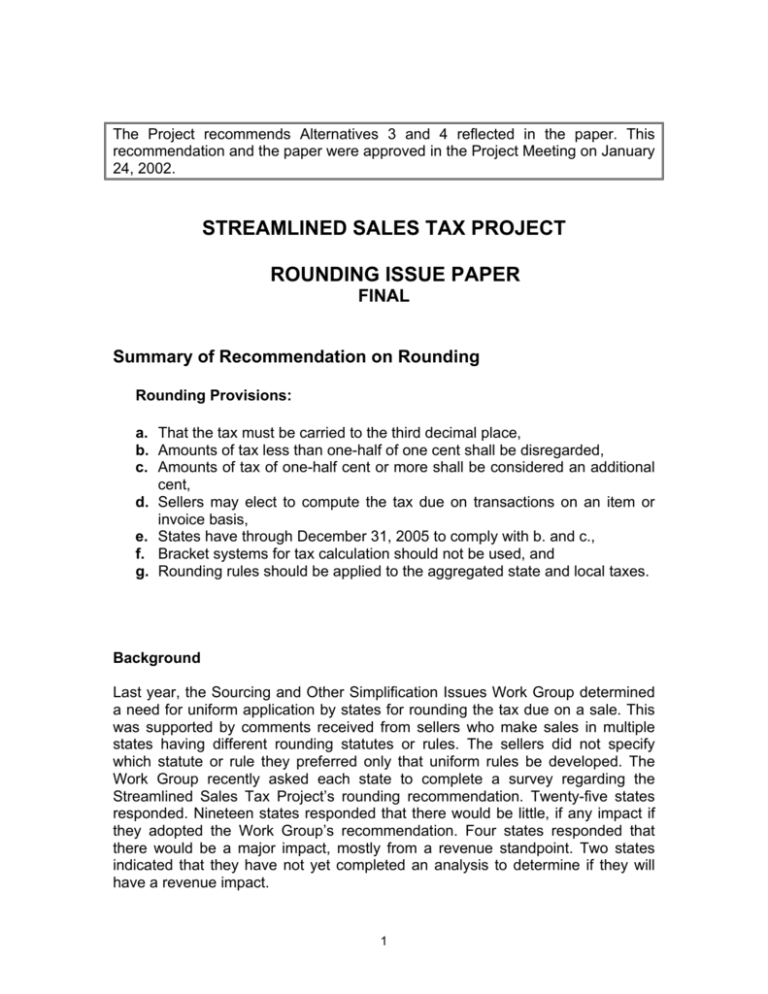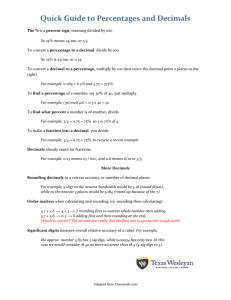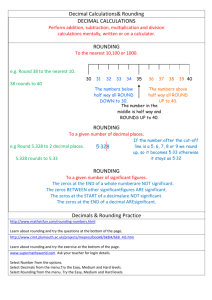Rounding Rule - Streamlined sales tax
advertisement

The Project recommends Alternatives 3 and 4 reflected in the paper. This recommendation and the paper were approved in the Project Meeting on January 24, 2002. STREAMLINED SALES TAX PROJECT ROUNDING ISSUE PAPER FINAL Summary of Recommendation on Rounding Rounding Provisions: a. That the tax must be carried to the third decimal place, b. Amounts of tax less than one-half of one cent shall be disregarded, c. Amounts of tax of one-half cent or more shall be considered an additional cent, d. Sellers may elect to compute the tax due on transactions on an item or invoice basis, e. States have through December 31, 2005 to comply with b. and c., f. Bracket systems for tax calculation should not be used, and g. Rounding rules should be applied to the aggregated state and local taxes. Background Last year, the Sourcing and Other Simplification Issues Work Group determined a need for uniform application by states for rounding the tax due on a sale. This was supported by comments received from sellers who make sales in multiple states having different rounding statutes or rules. The sellers did not specify which statute or rule they preferred only that uniform rules be developed. The Work Group recently asked each state to complete a survey regarding the Streamlined Sales Tax Project’s rounding recommendation. Twenty-five states responded. Nineteen states responded that there would be little, if any impact if they adopted the Work Group’s recommendation. Four states responded that there would be a major impact, mostly from a revenue standpoint. Two states indicated that they have not yet completed an analysis to determine if they will have a revenue impact. 1 Methods of Rounding The survey showed that states use three different methods for sellers to determine the tax due on a sale when involving a fraction of a cent. Three states use a bracket system to determine the tax owed and 22 states allow rounding when the tax due on a sale or on a return involves a fraction of a cent or dollar. Of those 22 states, four states indicated they round up to the nearest cent, and nine round up for anything .5 and over and round down for anything below .5. The Work Group recommended that states adopt the latter method because we felt it was the most acceptable method for consumers who might otherwise feel that the state was being enriched at their expense. For those states that have a round up rule or brackets, this change will have some revenue impact. Decimal Points for Tax Due The survey also shows that states employ different rules for how far sellers are required to carry out the decimal places in determining the tax due. One state carries out to one decimal place, one state carries out two decimal places, 14 states carry out to three decimal places, one carries out to four places, and one state carries out to six decimal places. Last year, the Work Group recommended that sellers be required to carry out to three decimal places, since this was the method most used by states. Rounding on Tax Returns Last year, the Work Group recommended the states which allow taxpayers to round to the nearest dollar on their tax returns when they report the tax owed be allowed to continue this practice. Our survey shows that four states require taxpayers to use this method and one state encourages (but does not require) this method. Taxing Separate Items or Invoice The Work Group also considered two alternate approaches to a rounding statute. One approach requires the seller to charge tax on the aggregate taxable amount of the sale if there are multiple taxable items being purchased at one time. The other approach would have sellers charge tax on each individual taxable item being sold where multiple taxable items are being purchased at one time. The Work Group heard from some sellers that they would prefer to charge tax separately on each taxable item included in the sale rather than on the total amount. The Work Group was concerned, however, that some customers may find this confusing and some vendors without computer systems would find it difficult to comply. The survey shows that 16 states either require or allow rounding on the total invoice amount and six states allow the sellers to choose 2 either method, as long as it is consistently used. One state reports requiring rounding on the invoice amount except in cases where a maximum tax is involved. Another state reports that rounding on the total invoice is required for certain taxpayers, while rounding on each item on the invoice is required for others. The Work Group determined it would be best to leave this issue to the sellers. Since this proposal calls for arithmetic rounding, any differences caused by sellers using different approaches should be insignificant. Technology Costs Two technology companies were interviewed for their perspectives on technology costs on rounding rules. The technology companies indicated: 1. There is very little incremental technology cost in having multiple algorithmic rounding points (i.e., rounding up at $0.005, $0.001. etc) 2. Bracket systems are expensive to program and maintain. It is a major applications development effort to change the brackets every time there is a rate change. Also, brackets slow down the processing speed of a system, a detriment to merchants with a need for speed. Eliminating brackets will reduce the costs of technology. 3. Rounding rules should be applied to the aggregated state and local taxes. Technology costs will double if any state requires rounding at the state tax level and then rounding at the local level. 4. The technology companies had different opinions abut rounding at the item or invoice level. Since the agreement allows an option, the Project is meeting the needs of both technology companies. Alternatives 1. The Streamlined Sales and Use Tax Agreement as approved by the Project on December 22, 2000 and amended by the Project on January 24, 2001, provides (a) that the tax must be carried to the third decimal place, (b) amounts of tax less than one-half of one cent shall be disregarded, (c) amounts of tax of one-half cent or more shall be considered an additional cent, and (d) sellers may elect to compute the tax due on transactions on an item or invoice basis. The Project may recommend that these rounding provisions be approved by the implementing states. 2. The Project may approve more than one rounding algorithm since the technology companies have indicated there is not much administrative cost in multiple rounding algorithms. The Project should still maintain that tax must be carried to the third decimal place and that sellers may elect to compute the tax due on transactions on an item or invoice basis. 3 3. The Project may recommend that states be provided additional time to get to one rounding algorithm, much like is allowed for state and local tax bases (differences allowed until December 31, 2005), caps and thresholds (a state may continue their caps and thresholds until December 31, 2005), and multiple state rates (a state must have only one state rate after December 31, 2005). The Project should still maintain that tax must be carried to the third decimal place and that sellers may elect to compute the tax due on transactions on an item or invoice basis. This alternative may satisfy the business community that believes that the states ought to be able to get to one rounding algorithm in any simplified system. 4. Regardless of which alternative is selected above, the Project should endorse the elimination of bracket systems and that rounding rules should be applied to the aggregated state and local taxes. (These are not currently provided in the Agreement.) The technology companies and businesses participating in the Project indicate that technology costs will be higher if the Agreement does not provide for these rules. 4 The Streamlined Sales Tax Project is recommending that states adopt the following. What impact, if any, would your state experience if you adopted the Project's recommendations (Please indicate the revenue impact for each of the recommendations mentioned.) Streamlined Sales Tax Project Rounding Survey April 2001 Does your state require rounding to the nearest dollar when reporting the tax amount on your return? State Does your state allow Name rounding when the tax due on a sale or on a return involves a fraction of a cent or dollar? If yes, does your state allow/require rounding on each invoice item or on the total invoice amount? How many decimal places are sellers required to use in determining the amount of tax due when rounding is used? AR Yes Total invoice When calculating the amount Yes of tax a customer owes, the seller can round up at .005. When calculating the amount of tax a seller owes the state, the seller is required to round up to the nearest dollar .5. CT Yes Total invoice Four GA We have a bracket system that The total invoice provides the calculation necessary to uniformly round these fractions. Our bracket system rounds No, but I wish we did. up on the half cent beginning at 11 cents and changes at 25 cent intervals. IN Yes. If the tax computed results Total invoice amount in a fraction of $.005 or more, the amount of tax shall be rounded to the next additional cent. Three No IA Yes Three Yes Either Round up for anything .5 When and over, and round down determining the for anything below .5. amount of tax due, carry out to the third decimal place. No impact for reporting tax on returns – major impact if this applies to sales to customers. No 5 Round to the nearest dollar when reporting the amount on your return. No impact No impact This is similar to what we do and should not have a material fiscal impact in GA. Minimal fiscal impact This is in line with current Indiana practices. This may require a statute change in Indiana. We are unable to determine the revenue impact of such a change, but we have to assume it would be a positive number. This recommendation is similar to the way we handle rounding and as such we have not identified any revenue impact. KS For Kansas sales tax reporting, Kansas has a state sales For Kansas sales tax rounding is only allowed to a and use tax rate of 4.9%. reporting rounding is only cent. Tax is calculated on the allowed to a cent. total invoice amount - not on the individual invoice line items. When this calculation is made, rounding to the nearest cent is allowed. That is, rounding should be done for anything $00.005 and over, and down for anything below $00.005. No. It is not required, or even allowed. Rounding is only allowed to a cent. KY Yes No MD Maryland law required rounding Maryland law requires One. The Maryland tax is to the next highest cent. the tax to be applied to imposed on each separate the total invoice amount. sale and not upon gross receipts. Total invoice amount Third decimal point No 6 There would be significant costs associated with changing our system from its current programming to one that allows rounding. In addition to the costs, a great deal of time would be expended. The streamlined system envisions the filing of computer-generated tax returns. If we are moving to computer-generated filings, why would there be any benefit in rounding to the nearest dollar? Computer reporting is not labor intensive and such reporting should reduce or eliminate the chances of human error. The sales numbers reported to the States will be generated directly from customer billings and then handled by computers thereafter until an electronic return is filed. The traditional benefits from rounding to a dollar amount, such as reducing the chances of human error or the time spent entering two more numbers, will be eliminated when the streamlined sales tax reporting system is adopted. Clearly, rounding to the nearest dollar had real benefit for States under older reporting systems. However, rounding to the nearest dollar should not be a concern under the streamlined system or provide any benefit under any other system where tax reporting is handled by computer. Please note that my concerns are not a statement that Kansas opposes rounding to the nearest dollar amount - I simply am suggesting that rounding to the nearest dollar benefits States that utilize older reporting systems. There should be no benefit to States under the streamlined system. As noted, the numbers reported to the States will be generated directly from customer billings and then handled by computers thereafter until an electronic return is filed. Very little if any. Revenue loss in the range of $15, but potentially a lot higher. More importantly, every cash register in the State would have to be reprogrammed. At present, the Maryland 5% sales tax is calculated on each separate sale and not upon gross receipts. If this is a proposal to convert the tax to a 5% tax on gross receipts, the revenue impact is the same as in the first recommendation. In order for Maryland to produce the same amount of money as the present tax, a rate in the range of 5.006% would be required. If this is a proposal simply to drop cents from the face of returns, it probably has no revenue impact. MI Yes Either At least 3 No MN Yes Total invoice. Three Yes. MO Sale - yes, two decimal places. Sale - on the total invoice Sales - The taxpayer may No Return - No. amount. Return - N/A. use our tax rate charts which we provide for them or use three decimal places in determining the amount of tax due. Return - N/A. NE Yes. Fraction of a cent. The total invoice amount Three No NV Yes, rounding to nearest cent Yes, either or both No requirement No NJ New Jersey has a table that The table is applied to determines when the next the total invoice. penny is due. Currently, we do not have a rounding rule. N/A No NC Rounding is allowed on a sale. Rounding is Three We currently do not provide for predominately done on rounding on a return. the total invoice except in cases where a maximum tax is involved. No, we do not require rounding on a return. 7 Rounding to the nearest dollar amount would represent a change in Michigan's practices. We would expect the revenue impact of such a change to be neutral or minimal. Michigan's sales tax statute provides a bracket tax schedule for the first 99 cents of a sale. This bracket schedule is not based on a true mathematical rounding methodology. The brackets are not strictly adhered to, and as a result we expect that a change to mathematical rounding would substantially represent a reflection of actual business practice in Michigan. No impact. This is current practice. We have not completed an analysis to determine revenue impact for these recommendations. We do not have this information available. No impact Negligible $500,000 to $2.5 million - very rough, non-scientific estimate. No impact Initial tests indicate this will be a wash. However, we will need an estimated 12 programmer weeks to modify, test and implement the changes in all of the affected programs. None Impact unknown at this time. ND On a sale: No, North Dakota N/A sales tax law provides for a bracket system that applies to transactions under $1.00, as well as the portion of larger sales in excess of an even dollar amount. On a return: Yes, the taxpayer computes tax on the gross receipts and is instructed to round to the nearest whole dollar. N/A Yes OH Yes, Ohio does allow rounding Total invoice amount in lieu of using the bracketed tax collection schedules when computing tax on a sale. However, the rounding rule requires always rounding up to the next cent in tax. Six Recent legislation allows the commissioner to require rounding to the nearest dollar on tax returns. This legislation went into effect in September 2000 (after tax return booklets and instructions were designed for tax year 2001) Rounding instructions will be placed in tax return booklets and will go into effect for sales/use tax returns filed for periods in year 2002. Significant impact. The revenue About the same as impact study done by our Tax the first Analysis Office was predicted recommendation. on an "Average Taxable Sale Amount". Assuming an Average Sale Amount of $10, the projected annual revenue loss would be $53 Million. For a $15 Average Sale Amount, a loss of $35 Million. For an Average Sale Amount of $25, the projected loss would be $21 million. RI Yes Either, but the retailer has to use one or the other. Three No With the exception of rounding the return to the nearest dollar, there would be no impact. Under the rounding rules proposed, there should be minimal impact rounding the returns due to the offset of rounding up as well as down. SD Yes There is nothing in statute or regulation requiring or allowing either. The taxpayer must choose the option that most reflects the most accurate tax collection. There is nothing in statute or We do not allow regulation. The department's rounding to the nearest practice is to round to the dollar on tax returns. nearest penny using the third decimal. 8 Small fiscal effect None Currently being applied - no revenue effect. Minimal impact. We are working on this estimate. UT Yes. A vendor may not collect as tax an amount, without regard to fractional parts of one cent, in excess of the tax computed at the rates prescribed by this chapter. (See Utah Tax Code Annotated Section 59-12-107(2)(b)). Invoice amount. The Tax Commission furnishes tables that may be used to determine the proper amount of 5ax on each transaction. (See Administrative Rule R865-19S-6) TN Yes, round to the nearest cent on the total invoice amount to calculate the tax on a sale. Yes, round to the nearest dollar on the sales and use tax return. Pursuant to Rule 1320-5- Three 1-.77, rounding is allowed on the total invoice amount for certain types of taxpayers. Other taxpayers must calculate the tax on the sales price of item on an invoice. The reason for this has been the need to determine the amount of local option sales tax due on each “single article” of tangible personal property. The first $1,600 of a “single article” of tangible personal Tenn. Code Ann. 67-6504(e) – Any dealer who is liable for the tax imposed by this chapter may round off all figures used to the nearest dollar amount. Tennessee does not require a taxpayer to do this. Our sales and use tax returns all have 00 in the cents column. VT Vermont requires collection based on a rate chart which rounds to the next higher whole cent. It allows reporting and payment by rounding gross sales and nontaxable sales to the nearest whole dollar. The statute is silent and there is no published rule. We have understood the requirement to be to compute the tax on the total taxable charges on an invoice. No rule. No. WA Yes on returns. No on individual items within an invoice. This reflects what I understand our practice to be. We don’t have laws or rules covering this. We would allow rounding on the total invoice amount, but not on each invoice item. Again, this reflects my understanding of our practice and is not covered by rule or law. Don’t really have an answer. We encourage it, but On the return, taxpayers don’t require it. compute to the cent and round to the dollar. For calculating the tax on each invoice, 2 decimal places. For reporting the tax on the return, nearest dollar. We are in the process of amending our procedures to require rounding to the nearest dollar for sales tax reporting. Currently, reporting is to 2 decimal places. 9 No revenue impact, as we will be requiring rounding to the nearest dollar for sales tax reporting. Would probably result Would expect little in a positive revenue revenue impact impact. since we are amending our reporting procedures to be in line with this procedure. No fiscal impact since Tennessee already does this. I believe that the only impact will be on the vendors, who now keep the overcollection "breakage" caused by rounding up at collection, but not at paying. It would put pressure on the state to allow a vendor discount (which we don't now). I have no estimate of the actual dollar impact. At this time, we don’t know the impact, if there is one, for any of the three. Our research people are looking at this. We will keep you informed. WI Yes, we provide 2 methods of rounding to the nearest cent. One is through the bracket system - the tax to be collected for the portion of a sale that is not equal to an even dollar is predetermined. For example, the tax due on a sale of an item costing $1.12 is $0.05 on the dollar portion of this sale and $0.01 for the portion of the sale between $0.10 and $0.29. So, the retailer would collect $0.06. The other method is the Alternative bracket system - the retailer multiplies the aggregate sales price of all items sold in a single transaction by the tax rate. Then the tax collected is rounded to the nearest cent. WY Yes, we allow rounding when We allow rounding of the We require rounding to the the tax due on a sale or on a total invoice. third place. return when it involves a fraction of a cent. Not a fraction of a dollar. Rounding is done on the Three. total invoice (taxable items). The retailer is not allowed to round tax on each item, thy must use an aggregate sales price of all taxable items sold on a single invoice before calculating the tax amount. No. Fine. Minimal revenue impact. We do not allow We would have to adjust our systems to allow rounding on the return to the rounding to the nearest nearest dollar. dollar on returns. 10





